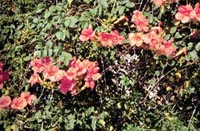Resource Library
Plant of the Week: Vine, Trumpet (Trumpet Creeper)
The University of Arkansas System Division of Agriculture does not promote, support or recommend plants featured in "Plant of the Week." Please consult your local Extension office for plants suitable for your region.
Plant of the Week
Trumpet Creeper, Trumpet Vine
Latin: Campsis radicans

I’m afraid of vines. I like the idea of vines in the garden, the beauty of vines and the utility of vines, but they scare me. Whenever I hear a gardener ask how to care for wisteria, I shutter in apprehension of things to come, when the rampant vine will crawl through the window and strangle the hapless homeowners as they sleep.
This fear of vines probably dates to my childhood, when a trumpet creeper grew by my bedroom window. Not only did I have to worry about spooks under the bed, I had to keep a nervous eye turned to the windowsill.
Trumpet creeper is a native American vine that, for all its beauty, is not often found in gardens. It blooms in early summer on current season growth and produces clusters of funnel-shaped orange flowers, three inches long with the five petal lobes out-turned at the ends of finger-sized tubes. The flowers are followed by a six-inch elongated bean-like capsule, readily identifying them as members of the Bignoniaceae family. The leaves are compound with nine to 11 leaflets.
Plants climb by attaching themselves to structures by means of aerial roots, and also by twining around each other and whatever it is growing on.
Though the common flower color is orange, a wide array of flower colors occur naturally.
Yellow and red forms are fairly common and are available from nurseries offering this species. One of the most beautiful forms is called ‘Apricot,’ with its subtle hues of orange and yellow commingled.
A selection of the Chinese species, C. grandiflora, called ‘Morning Calm,’ has the same color as ‘Apricot,’ but the Asian species has larger flowers and it doesn’t grow as fast as our native species. Dr. Mike Dirr at the University of Georgia has done breeding work with this and the Asian species and will probably be releasing some large-flowered form in the near future.
The place for trumpet creeper in the landscape is covering something ugly. Chain link fences come quickly to mind, but it could just as easily be used to cover rock piles and ugly retaining walls.
Hummingbirds favor this flower when it blooms. Nurseries advertising in the Sunday supplement section of the newspaper often offer this plant as the "hummingbird vine," obscuring the fact that it is a common native vine throughout the southeastern states.
Trumpet creeper is tough and vigorous. It requires full sun to flower well, but otherwise is free-flowering even while relatively young. It has tremendous drought tolerance, probably because of its ability to root so deeply into the soil. I’ve heard stories that when the drainage ditches were dug in the Arkansas Delta, trumpet creeper roots were found growing as deep as 20 feet.
While trumpet creeper is a vigorous grower, it is a piker when compared to wisteria. So, if you need a vine but are afraid of wisteria, consider this native plant the next time something ugly needs hidden.
By: Gerald Klingaman, retired
Extension Horticulturist - Ornamentals
Extension News - June 30, 2000
The University of Arkansas System Division of Agriculture does not maintain lists of retail outlets where these plants can be purchased. Please check your local nursery or other retail outlets to ask about the availability of these plants for your growing area.